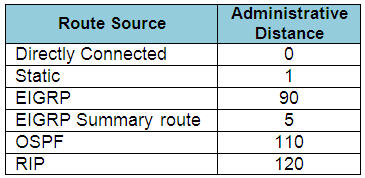Question 1
Question 2
Question 3
Explanation
The Broadcast network type is the default for an OSPF enabled ethernet interface (while Point-to-Point is the default OSPF network type for Serial interface with HDLC and PPP encapsulation).
Reference: https://www.oreilly.com/library/view/cisco-ios-cookbook/0596527225/ch08s15.html
Question 4
Question 5
Question 6
Explanation
Router2 does not have an entry for the subnet 10.10.13.128/25. It only has an entry for 10.10.13.0/25, which ranges from 10.10.13.0 to 10.10.13.127.
Question 7
Explanation
The default OSPF network type for HDLC and PPP on Serial link is point-to-point (while the default OSPF network type for Ethernet link is Broadcast).
Question 8
Explanation
OSPF uses the following criteria to select the router ID:
1. Manual configuration of the router ID (via the “router-id x.x.x.x” command under OSPF router configuration mode).
2. Highest IP address on a loopback interface.
3. Highest IP address on a non-loopback and active (no shutdown) interface.
Question 9
Explanation
From the output we can see there are Designated Router & Backup Designated Router for this OSPF domain so this is a broadcast network (point-to-point and point-to-multipoint networks do not elect DR & BDR) -> Answer B is not correct.
By default, the timers on a broadcast network (Ethernet, point-to-point and point-to-multipoint) are 10 seconds hello and 40 seconds dead (therefore answer C is correct). The timers on a non-broadcast network are 30 seconds hello 120 seconds dead.
From the line “Neighbor Count is 3”, we learn there are four OSPF routers in this OSPF domain -> Answer D is not correct.
Question 10
Explanation
With the same route (prefix), the router will choose the routing protocol with lowest Administrative Distance (AD) to install into the routing table. The AD of Internal EIGRP (90) is lowest so it would be chosen. The table below lists the ADs of popular routing protocols.
Image may be NSFW.
Clik here to view.
Note: The AD of IS-IS is 115. The “EIGRP” in the table above is “Internal EIGRP”. The AD of “External EIGRP” is 170. An EIGRP external route is a route that was redistributed into EIGRP.
Question 11
Explanation
The default-information originate command advertises a default route into a normal area, provided the advertising router already has a default route. But in the routing table of R1 we don’t see such a default route. Therefore we have to configure one.
Question 12
Explanation
The AD of eBGP (20) is smaller than that of OSPF (110) so the route to 10.10.13.0/25 will be updated as being learned from the new BGP path.